Dino Martens Oriente Murano Glass Vase
attributed to Dino Martens Oriente Murano glass vase, clear cased glass with inclusions in white, turquoise, red, black, yellow and bronze. Zanfirico band included and one large wheel in white and black. Italy, c 1950s, 30 cm high, 13.5 cm wide, 12 cm deep
You must be a subscriber, and be logged in to view price and dealer details.
Subscribe Now to view actual auction price for this item
When you subscribe, you have the option of setting the currency in which to display prices to $Au, $US, $NZ or Stg.
This item has been sold, and the description, image and price are for reference purposes only.
- Inclusions - Inclusions in glass objects refer to small, often irregularly shaped particles or bubbles that are trapped within the glass during the manufacturing process. These inclusions can be intentional or unintentional, and can range in size, shape, and composition.
Intentional inclusions are often added to the glass for decorative purposes, and can include materials such as colored glass, metallic foils, or even small mementos like photographs or other objects. These intentional inclusions are typically added to the glass while it is still in a molten or semi-molten state and are then moulded or blown into the final shape of the object.
Unintentional inclusions, on the other hand, are typically the result of impurities or air bubbles that become trapped within the glass during the manufacturing process. These inclusions can be seen as small specks or bubbles within the glass, and can sometimes be a sign of poor quality control during production.
While intentional inclusions can be a desirable feature of some glass objects, unintentional inclusions can sometimes be seen as a defect, and can reduce the value of a piece. However, in some cases, certain types of unintentional inclusions can actually increase the value of a piece, such as with antique glass that contains bubbles or other imperfections that are characteristic of the time period in which it was made. - Cased Glass - Cased glass is a type of glassware that is made by sandwiching a layer of one colour of glass between two layers of another colour of glass. This technique is also known as "slip-casting" and "slip-decorated" or "overlay" glass. The process creates a decorative effect by contrasting the colours of the outer layers with the inner layer. The outer layers can be clear, opaque or coloured and the inner layer can be a different colour, or it can be left clear to create a more subtle effect.
The technique was first developed in the 19th century, primarily in Europe, and it was used to produce a wide range of decorative glassware such as vases, bowls, and bottles. Cased glass was particularly popular during the Art Nouveau period, when many glassmakers, including Loetz, Galle, Steuben and Tiffay began to experiment with different colours and designs to create unique and striking pieces of glassware. - Attributed - A cataloguing term where the item in the opinion of the cataloguers, is a of the period of the artist, craftsman or designer, and which probably in whole or part is the work of that person.
- Bronze - An alloy of copper and tin, traditionally in the proportions of about 9 parts of copper to 1 part of tin.
The discovery of bronze in Western Asia in the 4th century enabled people to create metal objects which were superior to those previoulsy possible because of its strength and hardness, and it has been used throughout the world for weapons, coins, tools, statuary and other decorative items.
It is very fluid in a molten state, and its hardness, strength when set, and non-corrosive properties makes it most suitable for casting sculpture.
This item has been included into following indexes:
- Martens, Dino (Italy) - Venetian / Murano glass, makers 32
- Venetian / Murano glass, housewares
